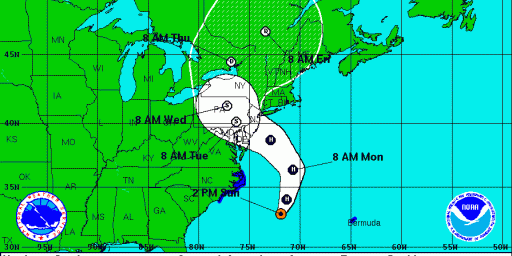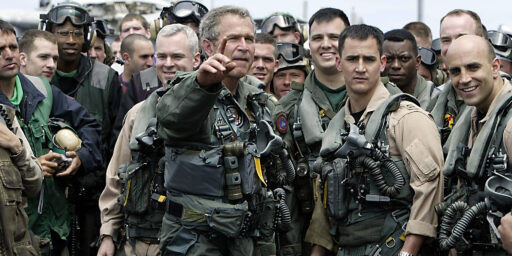QDR Pretends Iraq War a One-Off
Mark Mazzetti reports that the soon-to-be-released Quadrennial Defense Review reads as if the Iraq War never happened.
The U.S. military has long been accused of always planning to fight its last war. But as the Pentagon assesses threats to national security over the next four years, a major blueprint being completed in the shadow of the Iraq war will do largely the opposite. The military went into Iraq with a vision that a small, agile, and lightly armored force could win a quick preemptive war. Although the U.S. easily crushed Saddam Hussein’s army, the subsequent occupation has proven far costlier in lives, money and international standing than most expected. As a result, the U.S. military has no appetite for another lengthy war of “regime change.”
And while some new lessons will be incorporated into the Pentagon review, the spending blueprint for the next four years will largely stick to the script Pentagon officials wrote before the Iraq war, according to those familiar with the nearly final document that will be presented to Congress in early February.
Iraq “is clearly a one-off,” said a Pentagon official who is working on the top-to-bottom study, known as the Quadrennial Defense Review. “There is certainly no intention to do it again.”
For more than two years, Army officials have been fending off questions about whether they have enough troops to complete their mission in Iraq and racing to get armor plates bolted onto Humvees and supply trucks to defend against homemade bombs. But in the Pentagon blueprint, officials are once again talking about a futuristic force of robots, networked computers and drone aircraft. And they are planning no significant shift in resources to bulk up ground forces strained by the lengthy occupation of Iraq.
A one-off?!
On the contrary, it is the likely conflict type that will occupy the United States military for the next generation.
These are the major conflicts involving U.S. forces since 1990:
| Operation Name (Location) | Mission Type(s) |
| Desert Shield/Storm (Iraq-Kuwait) | Traditional |
| Provide Comfort/Northern Watch (Kurdistan) | Humanitarian/Stability |
| Southern Watch (Iraq) | Stability |
| Restore Hope (Somalia) | Humanitarian » Small War |
| Deliberate Force/Various others (Bosnia) | Aerial bombing/Stability |
| Support/Uphold Democracy (Haiti) | Stability |
| Allied Force / Noble Anvil (Kosovo) | Aerial bombing |
| Joint Guardian (Kosovo) | Stability |
| Enduring Freedom (Afghanistan) | Traditional » Stability/Counterinsurgency |
| Iraqi Freedom (Iraq) | Traditional » Stability/Counterinsurgency |
(A much more exhaustive list can be found here.)
It becomes quickly apparent that “traditional” wars, where we go in with large maneuver armies and fight against a similar enemy, defeat him, and go home are the one-offs. We have had, by my count, exactly one of those: Desert Storm.
That is being rather generous, since Desert Storm was quickly followed by two major humanitarian protection operations and half a dozen minor aerial bombardment operations in the succeeding twelve years. Not to mention a second major war that still occupies U.S. forces.
I share Rumsfeld’s vision of a high tech, mobile, flexible military. The idea that it will be used only for the types of wars we would prefer, however, is sheer fantasy.
Update: The editors at DefenseTech rounds up other coverage of the QDR and concludes,
Terrorist-type threats will get some new attention. But the Defense Department isn’t about to optimize for that threat, the way it did for the Soviet Union. Big money will continue to be spent on fighter jets designed to duel with the Soviets and destroyers designed for large-scale ground assaults. Grunts on the ground won’t get much more than they do now. The war on terror may be “long.†But, apparently, it’s not important enough to make really big shifts.
Marc Danziger is also puzzled by this and observes, “Today, as we’re playing ‘blink’ with Iran, the idea that we wouldn’t send a signal by starting the budget process with funds for – say – 150,000 more troops makes no sense whatsoever to me.”
Loren Thompson is not pleased, either. He notes, however, that it is mostly “a status quo document” and that focusing on the deviations from present policy gives the incorrect impression of radical change. That’s a good point. Having written a PhD dissertation on this topic, I can attest that change comes at glacial pace.






The preference for the “traditional” type of warfare embraced by the brass and big equipment contractors like Boeing and Lockheed Martin is on display when they talk up about the need to confront China. Lots of money to be made putting your markers on that one.
Huh? One of the (probably _the_) major driver behind the mess we’re currently in is that the neocons (in the person of Rumsfeld) wanted to prove their pet theories on fighting a ‘modern’ war.
So does ‘one-off’ mean that the military establishment is admitting that concept is a pile of crap?